Model-Based Analysis of the Oxygen Budget in the Black Sea Water Column
Abstract
1. Introduction
2. Methods
2.1. Model Description
2.2. Transport Model
2.3. Biogeochemical Model
2.4. Model Setup
3. Results and Discussion
3.1. Comparison with the Observations Data
3.2. Seasonal Variability
3.3. Oxygen Consumption
4. Conclusions
Author Contributions
Funding
Data Availability Statement
Acknowledgments
Conflicts of Interest
Appendix A
| BROM, Variable | Name | Notation, Unit | BROM, Variable | Name | Notation, Unit |
|---|---|---|---|---|---|
| Nitrogen | Manganese | ||||
| NH4 | Ammonia | NH, M N | Mn2 | Dissolved bivalent manganese | Mn(II), M Mn |
| NO2 | Nitrite | NO, M N | Mn3 | Dissolved trivalent manganese | Mn(III), M Mn |
| NO3 | Nitrate | NO, M N | Mn4 | Particulate quadrivalent manganese | Mn(IV), M Mn |
| PON | Particulate organic nitrogen | –, M N | MnS | Manganese sulphide | MnS, M Mn |
| DON | Dissolved organic nitrogen | –, M N | MnCO3 | Manganese carbonate | MnCO, M Mn |
| Phosphorus | Iron | ||||
| PO4 | Phosphate | PO, M P | Fe2 | Dissolved bivalent iron | Fe(II), M Fe |
| Silicon | Fe3 | Particulate trivalent iron | Fe(III), M Fe | ||
| Si | Dissolved silicon | Si, M Si | FeS | Iron monosulphide | FeS, M Fe |
| Sipart | Particulate silicon | –, M Si | FeS2 | Pyrite | FeS, M Fe |
| Oxygen | FeCO3 | Ferrous carbonate | FeCO, M Fe | ||
| O2 | Dissolved oxygen | O, M N | Sulphur | ||
| Ecosystem parameters | S0 | Total elemental sulphur | S, M S | ||
| Phy | Phototrophic producers | –, M N | S2O3 | Thiosulphate and sulphites | –, M S |
| Het | Pelagic and benthic heterotrophs | –, M N | SO4 | Sulphate | SO, M S |
| Bhae | Aerobic heterotrophic bacteria | –, M N | HS | Hydrogen sulphide | HS, M S |
| Baae | Aerobic autotrophic bacteria | –, M N | Carbon | ||
| Bhan | Anaerobic heterotrophic bacteria | –, M N | DIC | Dissolved inorganic carbon | –, M C |
| Baan | Anaerobic autotrophic bacteria | –, M N | CH4 | Methane | CH, M C |
| Alkalinity | CaCO3 | Calcium carbonate | CaCO, M Ca | ||
| Alk | Total alkalinity | Alk, M | |||
References
- Grégoire, M.; Soetaert, K. Carbon, nitrogen, oxygen and sulfide budgets in the Black Sea: A biogeochemical model of the whole water column coupling the oxic and anoxic parts. Ecol. Model. 2010, 221, 2287–2301. [Google Scholar] [CrossRef]
- Ünlülata, Ü.; Oğuz, T.; Latif, M.; Özsoy, E. On the physical oceanography of the Turkish Straits. In The Physical Oceanography of Sea Straits; Springer: Berlin/Heidelberg, Germany, 1990; pp. 25–60. [Google Scholar]
- Buesseler, K.O.; Livingston, H.D.; Casso, S.A. Mixing between oxic and anoxic waters of the Black Sea as traced by Chernobyl cesium isotopes. Deep Sea Res. Part A Oceanogr. Res. Pap. 1991, 38, S725–S745. [Google Scholar] [CrossRef]
- Murray, J.W.; Top, Z.; Özsoy, E. Hydrographic properties and ventilation of the Black Sea. Deep Sea Res. Part A Oceanogr. Res. Pap. 1991, 38, S663–S689. [Google Scholar] [CrossRef]
- Yakushev, E. Chemical Structure of Pelagic Redox Interfaces: Observation and Modeling; The Handbook of Environmental Chemistry; Springer: Berlin/Heidelberg, Germany, 2012. [Google Scholar]
- Murray, J.W.; Codispoti, L.A.; Friederich, G.E. Oxidation-reduction environments: The suboxic zone in the Black Sea. In Advances in Chemistry Vol. 244. Aquatic Chemistry; ACS Publications: Washington, DC, USA, 1995; pp. 157–176. [Google Scholar]
- Rozanov, A. Redox stratification in the Black Sea water. Okeanologiya 1995, 35, 544–549. [Google Scholar]
- Murray, J.; Jannasch, H.; Honjo, S.; Anderson, R.; Reeburgh, W.; Top, Z.; Friederich, G.; Codispoti, L.; Izdar, E. Unexpected changes in the oxic/anoxic interface in the Black Sea. Nature 1989, 338, 411–413. [Google Scholar] [CrossRef]
- Yakushev, E.; Pollehne, F.; Jost, G.; Kuznetsov, I.; Schneider, B.; Umlauf, L. Analysis of the water column oxic/anoxic interface in the Black and Baltic seas with a numerical model. Mar. Chem. 2007, 107, 388–410. [Google Scholar] [CrossRef]
- Yakushev, E.; Vinogradova, E.; Dubinin, A.; Kostyleva, A.; Men’Shikova, N.; Pakhomova, S. On determination of low oxygen concentrations with Winkler technique. Oceanology 2012, 52, 122–129. [Google Scholar] [CrossRef]
- Vinogradov, M.; Nalbandov, Y.R. Effect of changes in water density on the profiles of physicochemical and biological characteristics in the pelagic ecosystem of the Black Sea. Oceanology 1990, 30, 567–573. [Google Scholar]
- Tugrul, S.; Basturk, O.; Saydam, C.; Yilmaz, A. Changes in the hydrochemistry of the Black Sea inferred from water density profiles. Nature 1992, 359, 137–139. [Google Scholar] [CrossRef]
- Landing, W.M.; Lewis, B.L. Thermodynamic modeling of trace metal speciation in the Black Sea. In Black Sea Oceanography; Springer: Berlin/Heidelberg, Germany, 1991; pp. 125–160. [Google Scholar]
- Rozanov, A.; Demidova, T.; Egorov, A.; Lukashev, Y.F.; Stepanov, N.; Chasovnikov, V.; Yakushev, E. Hydrochemical structure of the Black Sea over the standard section from Gelendzhik to the center of the sea. Oceanology 2000, 40, 26–31. [Google Scholar]
- Konovalov, S.; Murray, J. Variations in the chemistry of the Black Sea on a time scale of decades (1960–1995). J. Mar. Syst. 2001, 31, 217–243. [Google Scholar] [CrossRef]
- Chasovnikov, V.K. Features of the Hydrochemical Structure of the Northeastern Part of the Black Sea. Ph.D. Thesis, MSU, Moscow, Russia, 2002. (In Russian). [Google Scholar]
- Yakushev, E.V.; Chasovnikov, V.; Debolskaya, E.; Egorov, A.; Makkaveev, P.; Pakhomova, S.; Podymov, O.; Yakubenko, V. The northeastern Black Sea redox zone: Hydrochemical structure and its temporal variability. Deep Sea Res. Part II Top. Stud. Oceanogr. 2006, 53, 1769–1786. [Google Scholar] [CrossRef]
- Statham, P.J. Nutrients in estuaries—An overview and the potential impacts of climate change. Sci. Total Environ. 2012, 434, 213–227. [Google Scholar] [CrossRef]
- Nixon, S.W.; Fulweiler, R.W.; Buckley, B.A.; Granger, S.L.; Nowicki, B.L.; Henry, K.M. The impact of changing climate on phenology, productivity, and benthic–pelagic coupling in Narragansett Bay. Estuarine Coast. Shelf Sci. 2009, 82, 1–18. [Google Scholar] [CrossRef]
- Rabalais, N.N.; Turner, R.E.; Díaz, R.J.; Justić, D. Global change and eutrophication of coastal waters. ICES J. Mar. Sci. 2009, 66, 1528–1537. [Google Scholar] [CrossRef]
- Lazar, L.; Vlas, O.; Pantea, E.; Boicenco, L.; Marin, O.; Abaza, V.; Filimon, A.; Bisinicu, E. Black Sea Eutrophication Comparative Analysis of Intensity between Coastal and Offshore Waters. Sustainability 2024, 16, 5146. [Google Scholar] [CrossRef]
- Yakushev, E.V.; Protsenko, E.A.; Bruggeman, J.; Wallhead, P.; Pakhomova, S.V.; Yakubov, S.K.; Bellerby, R.G.; Couture, R.M. Bottom RedOx Model (BROM v. 1.1): A coupled benthic–pelagic model for simulation of water and sediment biogeochemistry. Geosci. Model Dev. 2017, 10, 453–482. [Google Scholar] [CrossRef]
- Stanev, E.V.; He, Y.; Staneva, J.; Yakushev, E. Mixing in the Black Sea detected from the temporal and spatial variability of oxygen and sulfide–Argo float observations and numerical modelling. Biogeosciences 2014, 11, 5707–5732. [Google Scholar] [CrossRef]
- Capet, A.; Meysman, F.J.; Akoumianaki, I.; Soetaert, K.; Grégoire, M. Integrating sediment biogeochemistry into 3D oceanic models: A study of benthic-pelagic coupling in the Black Sea. Ocean Model. 2016, 101, 83–100. [Google Scholar] [CrossRef]
- Oguz, T.; Ducklow, H.; Malanotte-Rizzoli, P.; Tugrul, S.; Nezlin, N.P.; Unluata, U. Simulation of annual plankton productivity cycle in the Black Sea by a one-dimensional physical-biological model. J. Geophys. Res. Ocean. 1996, 101, 16585–16599. [Google Scholar] [CrossRef]
- Staneva, J.V.; Stanev, E.V. Oceanic response to atmospheric forcing derived from different climatic data sets. Intercomparison study for the Black Sea. Oceanol. Acta 1998, 21, 393–417. [Google Scholar] [CrossRef][Green Version]
- Grégoire, M.; Lacroix, G. Exchange processes and nitrogen cycling on the shelf and continental slope of the Black Sea basin. Glob. Biogeochem. Cycles 2003, 17, 1073. [Google Scholar] [CrossRef]
- Oguz, T.; Ducklow, H.W.; Purcell, J.E.; Malanotte-Rizzoli, P. Modeling the response of top-down control exerted by gelatinous carnivores on the Black Sea pelagic food web. J. Geophys. Res. Ocean. 2001, 106, 4543–4564. [Google Scholar] [CrossRef]
- Lebedeva, L.; Shushkina, E.A. Modelling the effect of Mnemiopsis on the Black Sea plankton community. Oceanol. Russ. Acad. Sci. 1994, 34, 72–80. [Google Scholar]
- Lancelot, C.; Martin, J.M.; Panin, N.; Zaitsev, Y. The north-western Black Sea: A pilot site to understand the complex interaction between human activities and the coastal environment. Estuarine Coast. Shelf Sci. 2002, 54, 279–283. [Google Scholar] [CrossRef]
- Yakushev, E. Numerical modeling of transformation of nitrogen compounds in the redox zone of the Black Sea. Oceanology 1992, 32, 173–177. [Google Scholar]
- Yakushev, E.V.; Neretin, L.N. One-dimensional modeling of nitrogen and sulfur cycles in the aphotic zones of the Black and Arabian Seas. Glob. Biogeochem. Cycles 1997, 11, 401–414. [Google Scholar] [CrossRef]
- Lima, L.; Aydogdu, A.; Escudier, R.; Masina, S.; Ciliberti, S.A.; Azevedo, D.; Peneva, E.L.; Causio, S.; Cipollone, A.; Clementi, E.; et al. Black Sea Physical Reanalysis (CMEMS BS-Currents) (Version 1) [Data Set]; Copernicus Monitoring Environment Marine Service (CMEMS): Ramonville-Saint-Agne, France, 2020. [Google Scholar]
- Bruggeman, J.; Bolding, K. A general framework for aquatic biogeochemical models. Environ. Model. Softw. 2014, 61, 249–265. [Google Scholar] [CrossRef]
- Gargett, A.E. Vertical eddy diffusivity in the ocean interior. J. Mar. Res. 1984, 42, 359–393. [Google Scholar] [CrossRef]
- Samodurov, A.; Ivanov, L. Processes of ventilation of the Black Sea related to water exchange through the Bosporus. Nato Sci. Ser. Environ. Secur. 1998, 47, 221–236. [Google Scholar]
- Pakhomova, S.; Rozanov, A.; Yakushev, E. Dissolved and particulate forms of iron and manganese in the redox zone of the Black Sea. Oceanology 2009, 49, 773–787. [Google Scholar] [CrossRef]
- Yakushev, E.; Chasovnikov, V.; Debolskaya, E.; Grégoire, M.; Podymov, O.; Yakubenko, V. The north-eastern Black Sea redox zone hydrochemical structure: Observed concentrations and estimated fluxes. In Proceedings of the International Conference Oceanography of the Eastern Mediterranean and Black Sea. Similarities and Differences of Two Interconnected Basins, Zappeion International Conference Centre, Ankara, Turkey, 14–18 October 2002. [Google Scholar]
- Gregg, M.; Yakushev, E. Surface ventilation of the Black Sea’s cold intermediate layer in the middle of the western gyre. Geophys. Res. Lett. 2005, 32. [Google Scholar] [CrossRef]
- Eilola, K.; Gustafsson, B.G.; Kuznetsov, I.; Meier, H.; Neumann, T.; Savchuk, O. Evaluation of biogeochemical cycles in an ensemble of three state-of-the-art numerical models of the Baltic Sea. J. Mar. Syst. 2011, 88, 267–284. [Google Scholar] [CrossRef]
- Konovalov, S.; Murray, J.; Luther, G.; Tebo, B. Processes controlling the redox budget for the oxic/anoxic water column of the Black Sea. Deep Sea Res. Part II Top. Stud. Oceanogr. 2006, 53, 1817–1841. [Google Scholar] [CrossRef]
- Volkov, I.; Rozanov, A.; Demidova, T. Reduced inorganic sulfur species and dissolved manganese in the water of the Black Sea. In Winter State of the Ecosystem of the Open Part of the Black Sea; Shirshov Institute of Oceanology RAS: Moscow, Russia, 1992; pp. 38–50. [Google Scholar]
- Greenwood, N.N.; Earnshaw, A. Chemistry of the Elements; Elsevier: Amsterdam, The Netherlands, 2012. [Google Scholar]
- Trouwborst, R.E.; Clement, B.G.; Tebo, B.M.; Glazer, B.T.; Luther III, G.W. Soluble Mn (III) in suboxic zones. Science 2006, 313, 1955–1957. [Google Scholar] [CrossRef]
- Sorokin, I. The Black Sea: Ecology and Oceanography; Biology of Inland Waters; Backhuys Pub.: Zuid-Holland, The Netherlands, 2002. [Google Scholar]
- Pimenov, N.V.; Neretin, L.N. Composition and activities of microbial communities involved in carbon, sulfur, nitrogen and manganese cycling in the oxic/anoxic interface of the Black Sea. In Past and Present Water Column Anoxia; Springer: Cham, Switzerland, 2006; pp. 501–521. [Google Scholar]
- Canfield, D.E.; Kristensen, E.; Thamdrup, B. Aquatic Geomicrobiology; Gulf Professional Publishing: Houston, TX, USA, 2005. [Google Scholar]
- Stunzhas, P.; Yakushev, E. Fine hydrochemical structure of the redox zone in the black sea according to the results of measurements with an open oxygen sensor and with bottle samplers. Oceanology 2006, 46, 629–641. [Google Scholar] [CrossRef]
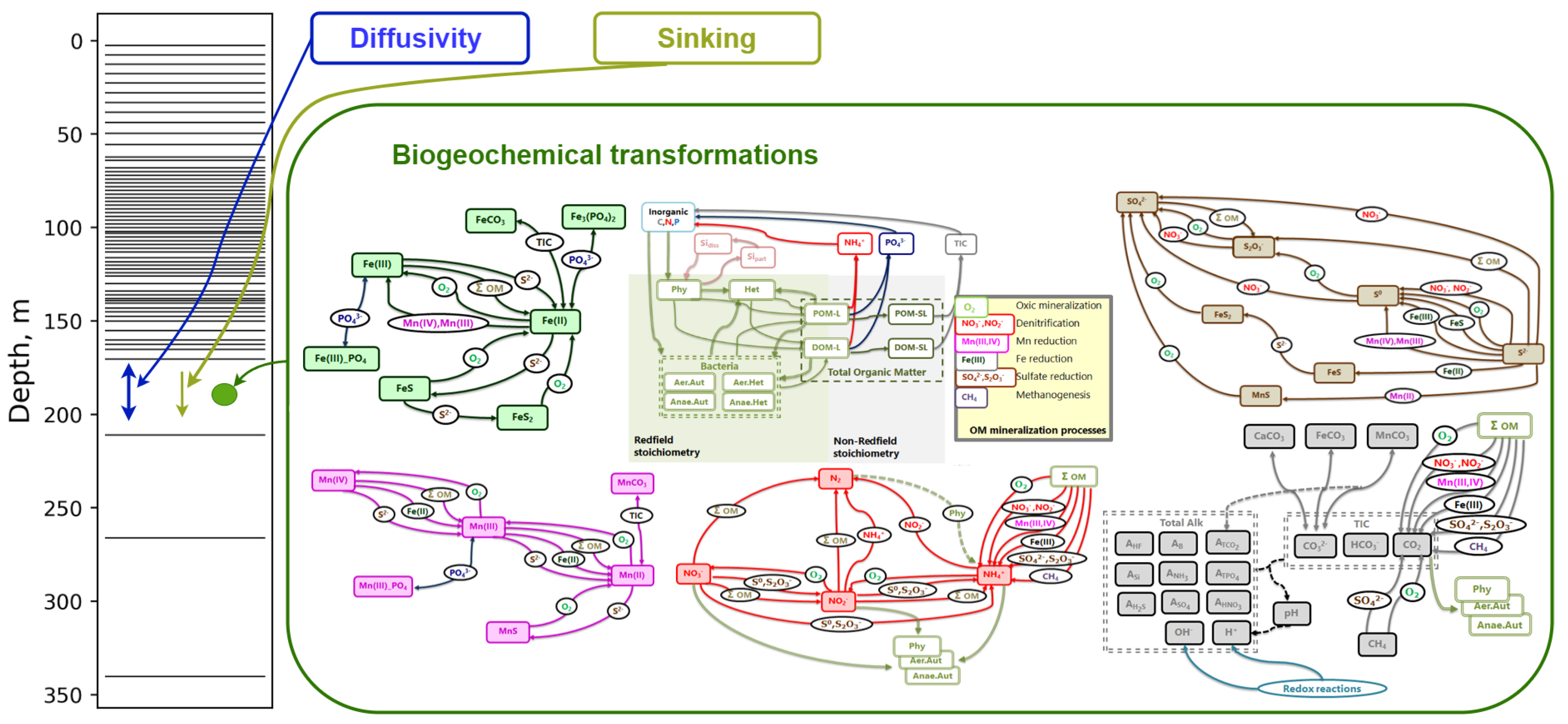
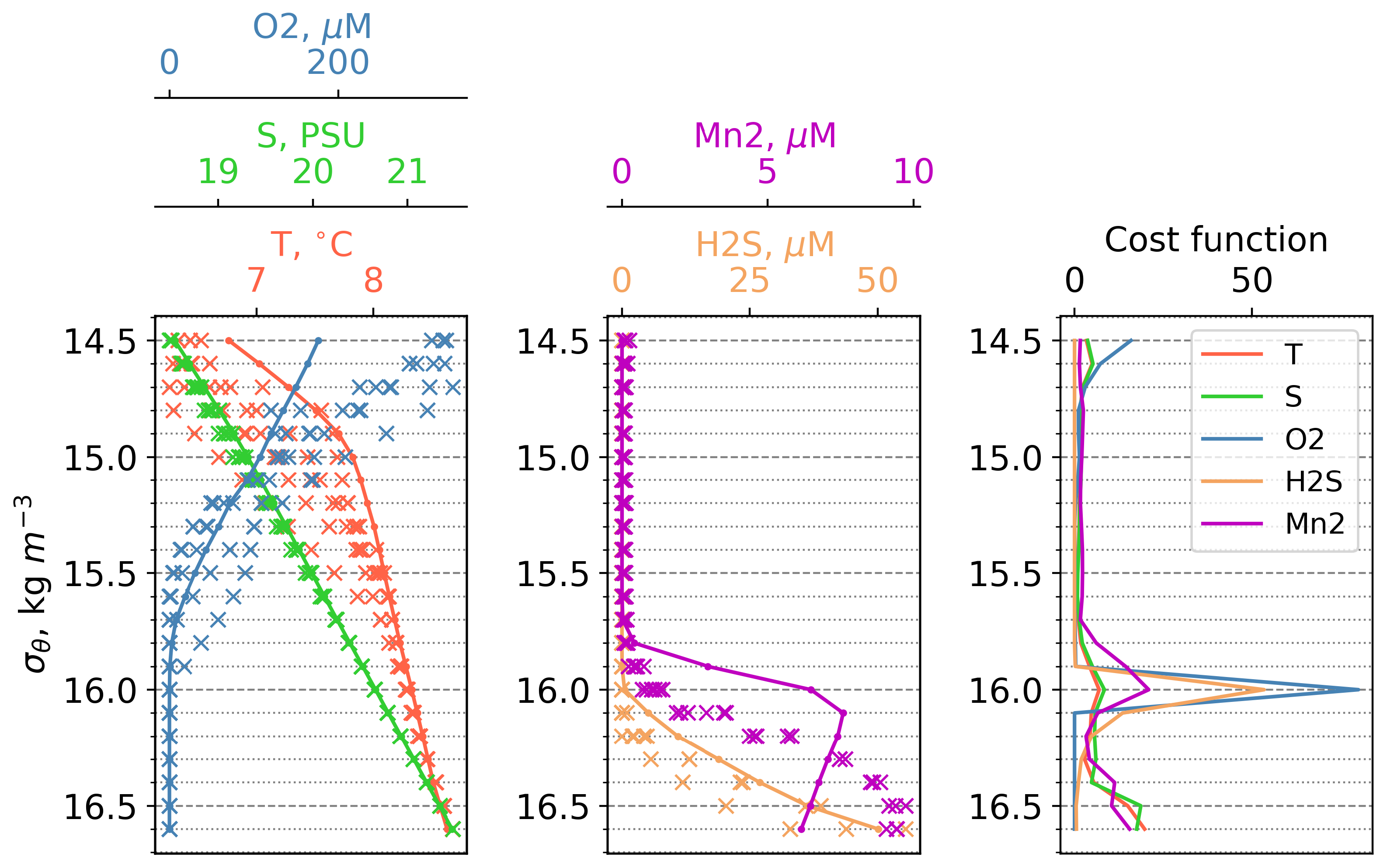
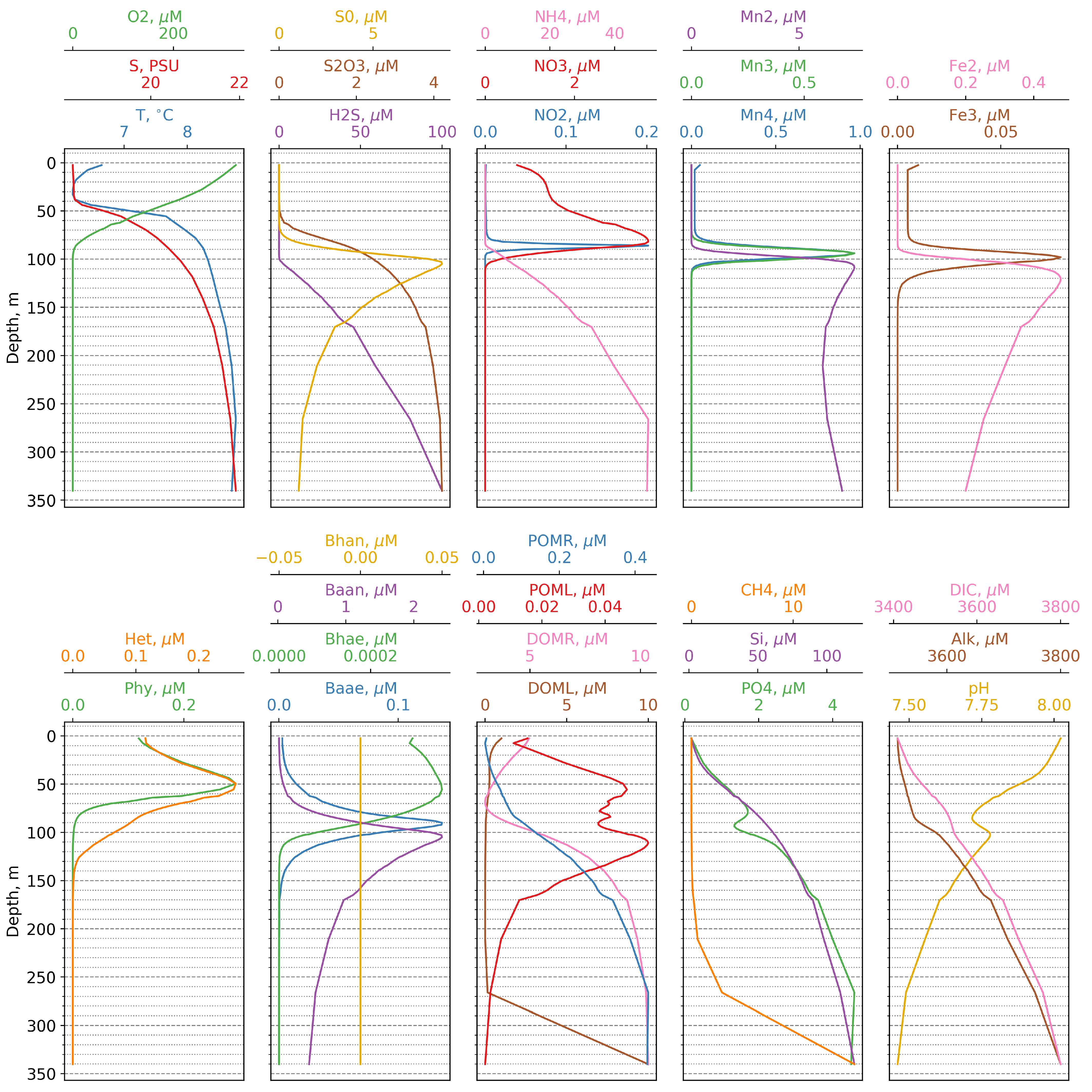

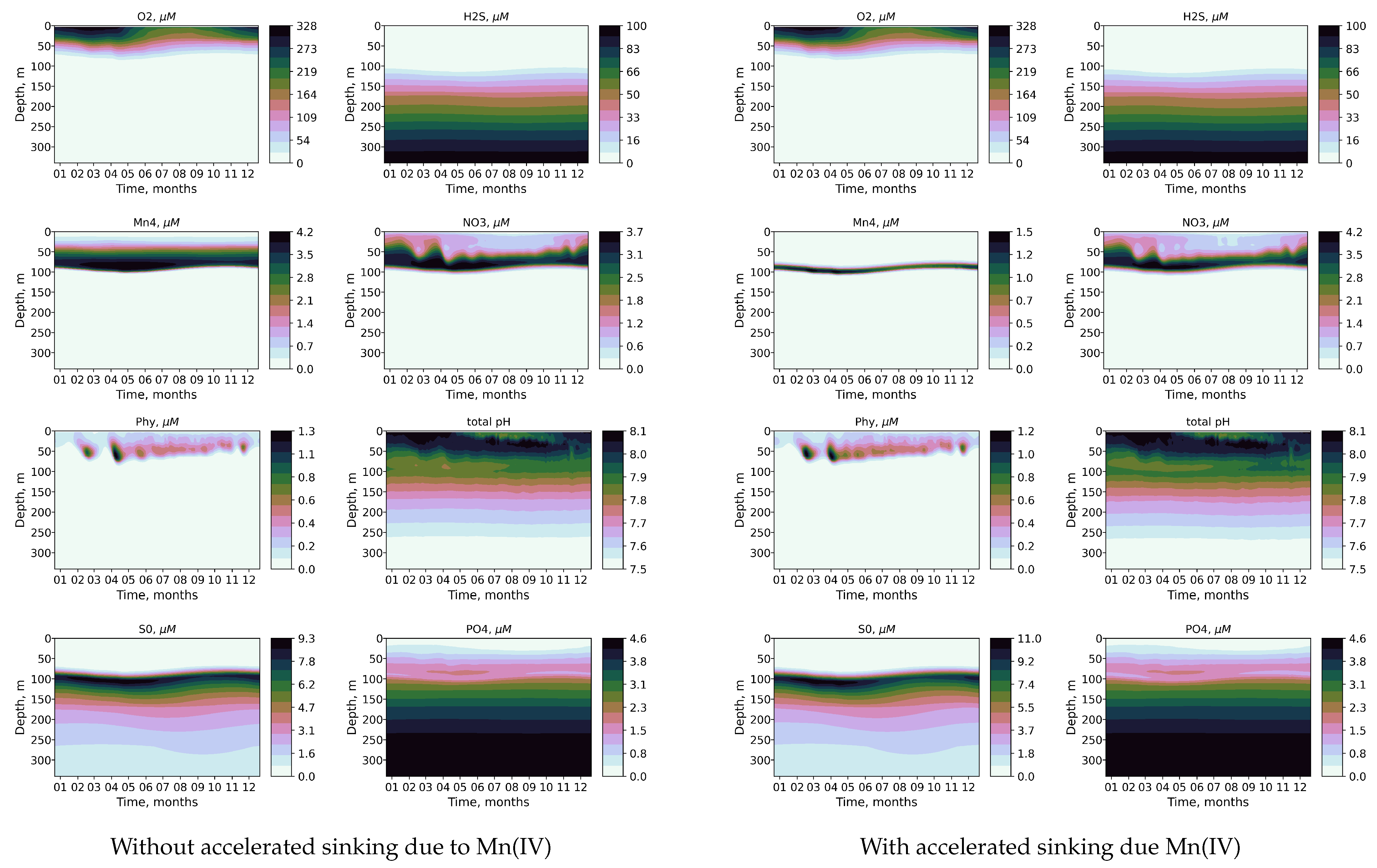
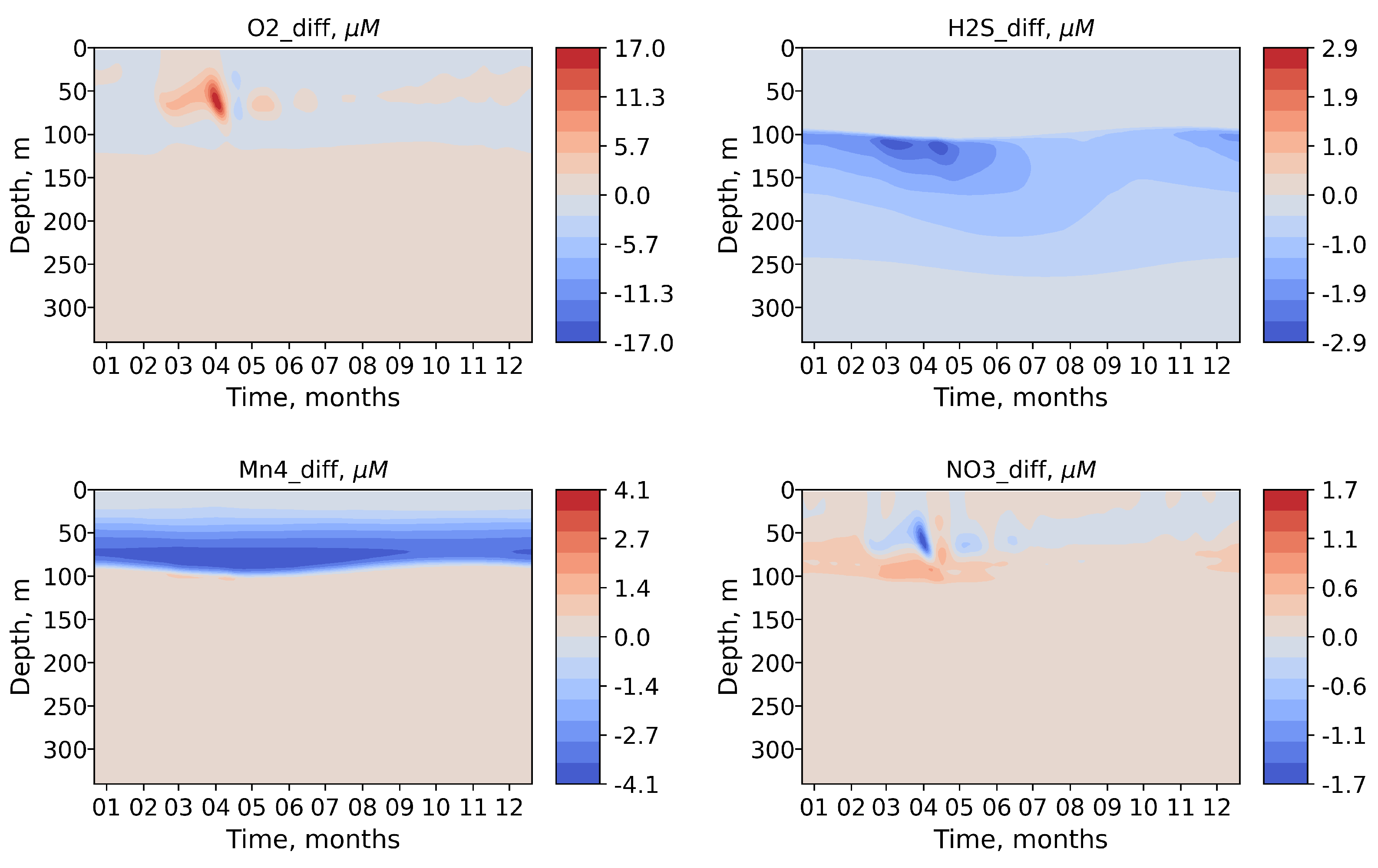
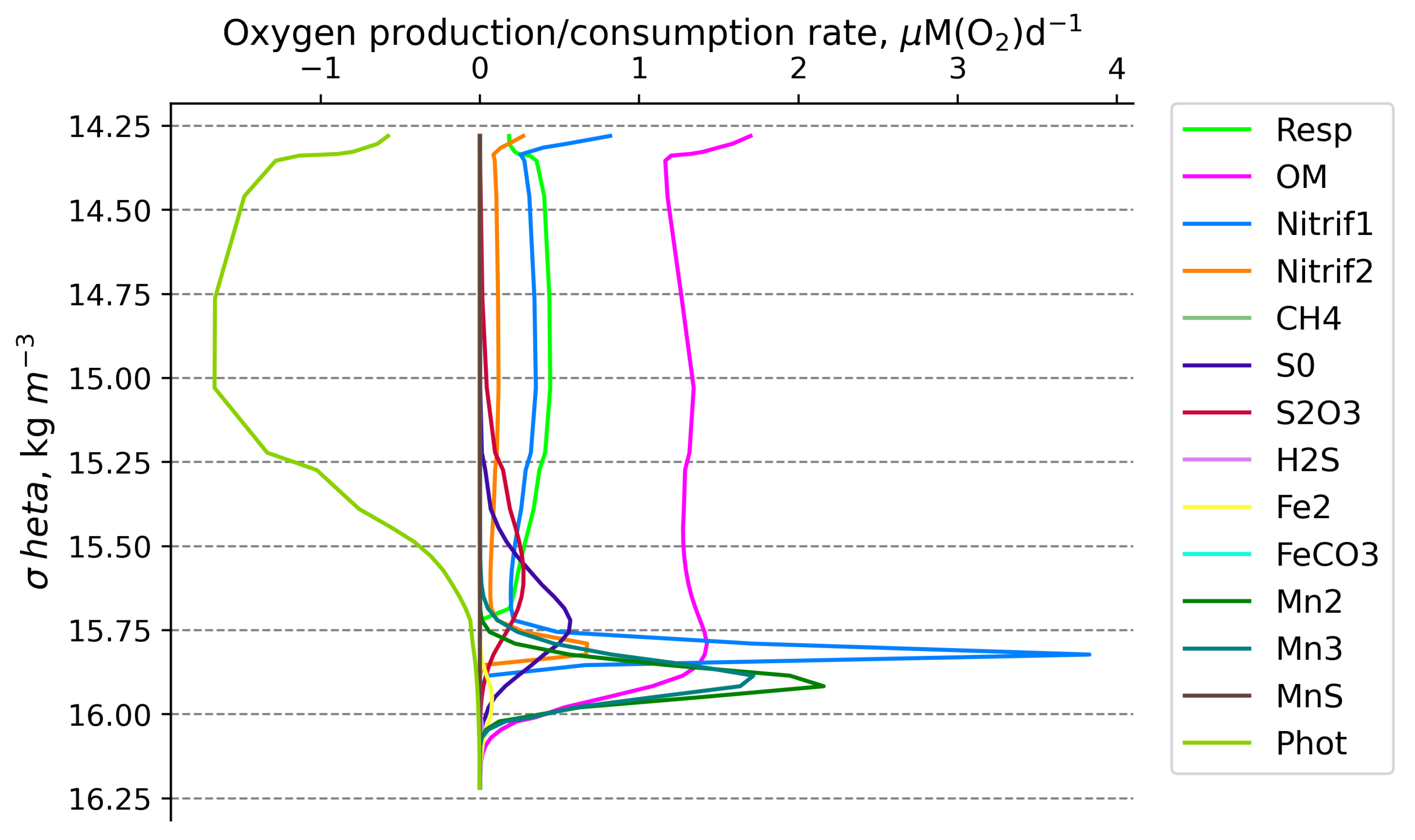
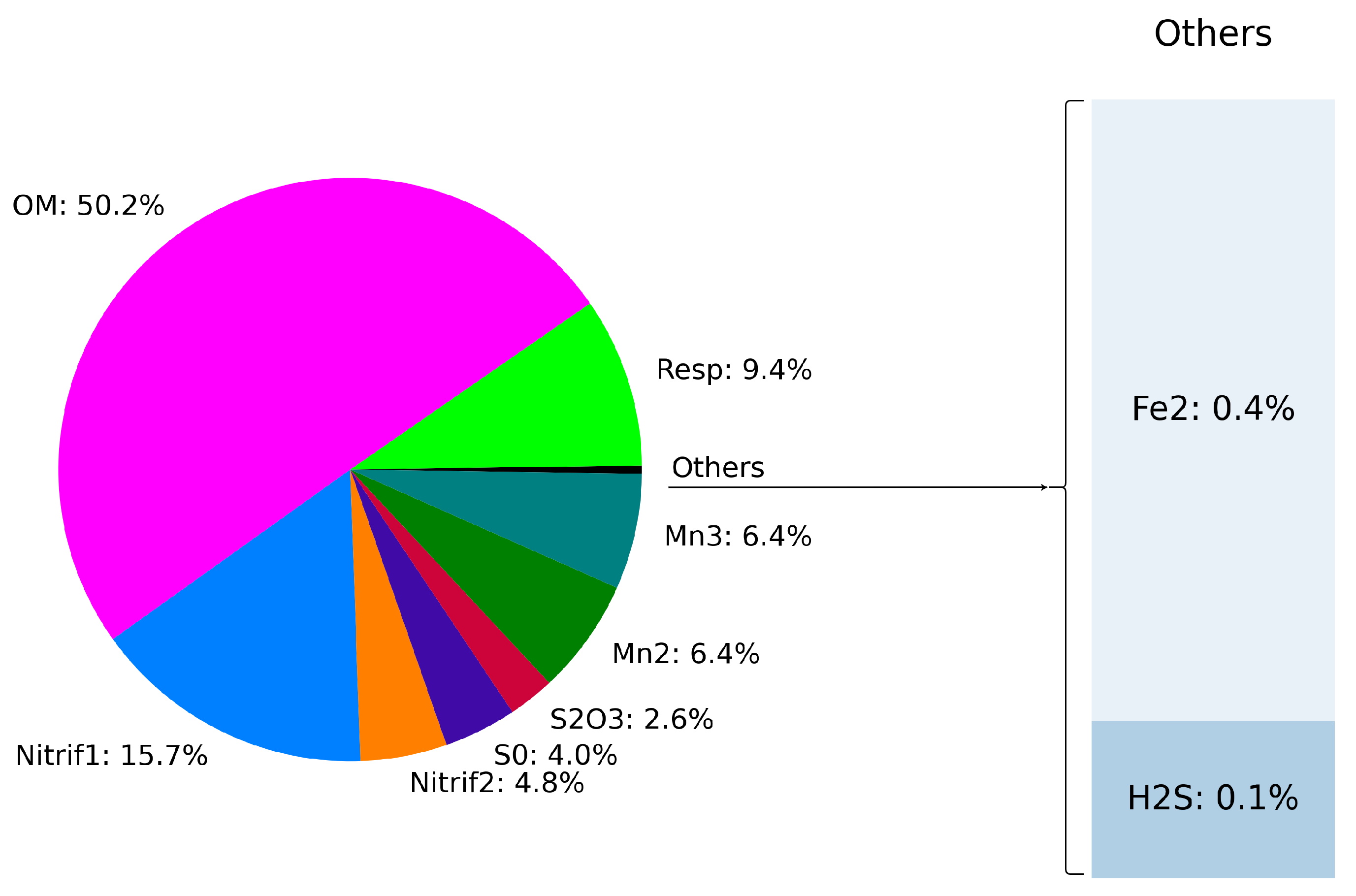
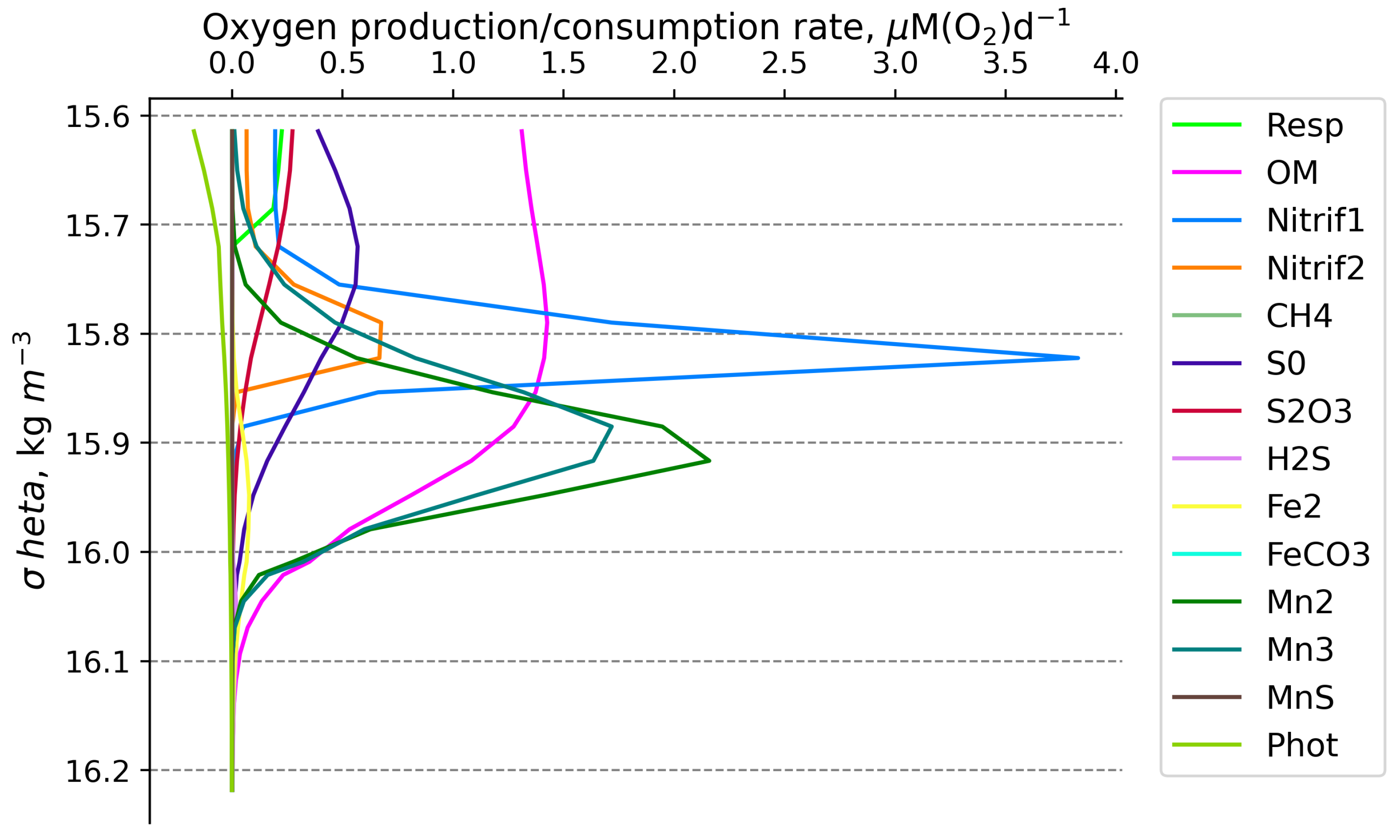
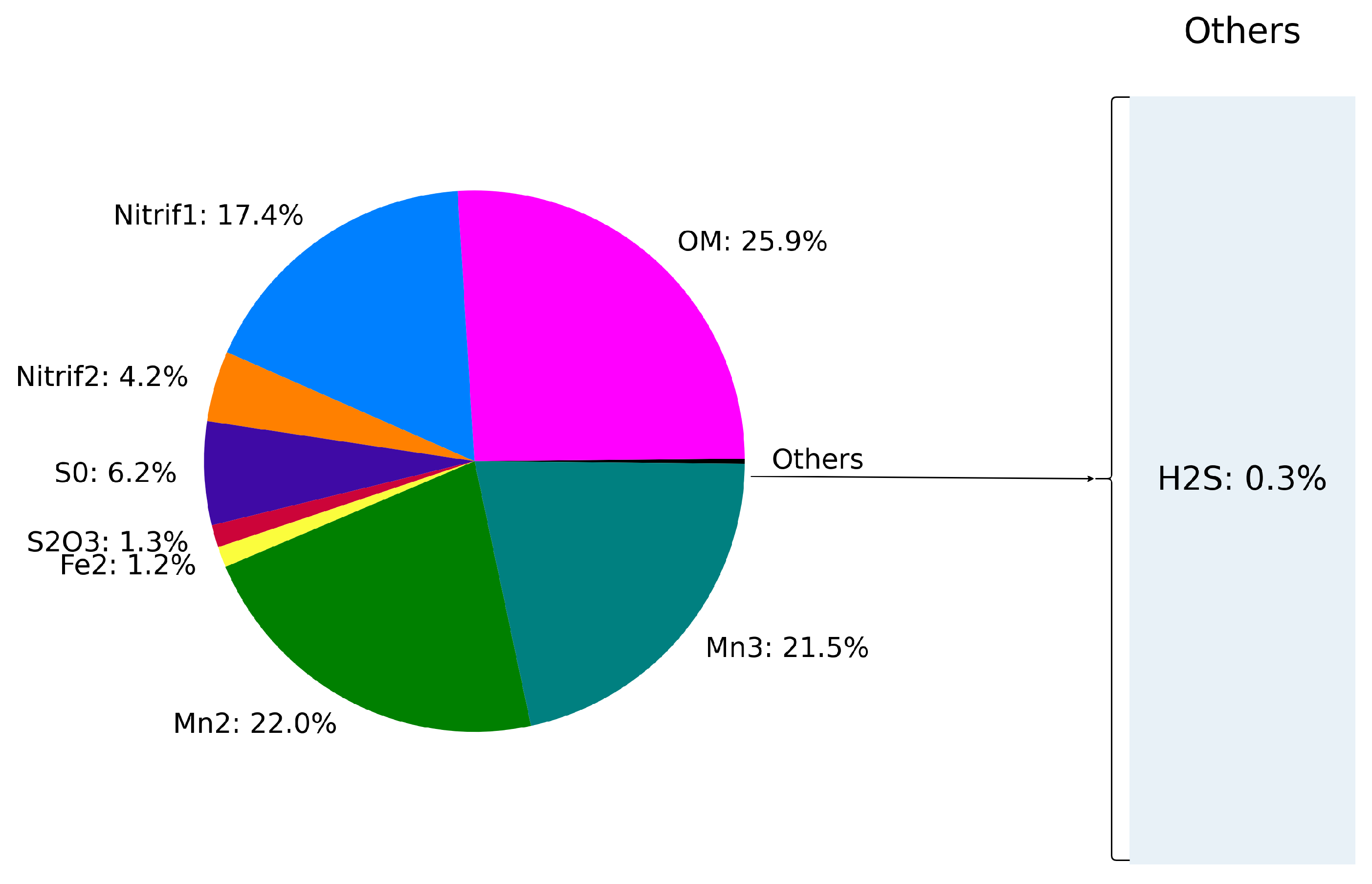
Disclaimer/Publisher’s Note: The statements, opinions and data contained in all publications are solely those of the individual author(s) and contributor(s) and not of MDPI and/or the editor(s). MDPI and/or the editor(s) disclaim responsibility for any injury to people or property resulting from any ideas, methods, instructions or products referred to in the content. |
© 2024 by the authors. Licensee MDPI, Basel, Switzerland. This article is an open access article distributed under the terms and conditions of the Creative Commons Attribution (CC BY) license (https://creativecommons.org/licenses/by/4.0/).
Share and Cite
Novikov, M.; Pakhomova, S.; Berezina, A.; Yakushev, E. Model-Based Analysis of the Oxygen Budget in the Black Sea Water Column. Water 2024, 16, 2380. https://doi.org/10.3390/w16172380
Novikov M, Pakhomova S, Berezina A, Yakushev E. Model-Based Analysis of the Oxygen Budget in the Black Sea Water Column. Water. 2024; 16(17):2380. https://doi.org/10.3390/w16172380
Chicago/Turabian StyleNovikov, Matvey, Svetlana Pakhomova, Anfisa Berezina, and Evgeniy Yakushev. 2024. "Model-Based Analysis of the Oxygen Budget in the Black Sea Water Column" Water 16, no. 17: 2380. https://doi.org/10.3390/w16172380
APA StyleNovikov, M., Pakhomova, S., Berezina, A., & Yakushev, E. (2024). Model-Based Analysis of the Oxygen Budget in the Black Sea Water Column. Water, 16(17), 2380. https://doi.org/10.3390/w16172380







